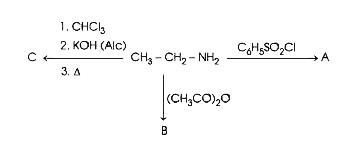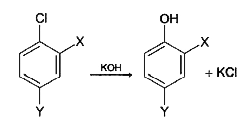Complete Solutions to CHEMISTRY of chapter NTA TPC JEE MAIN TEST 112 of Class 12 book with complete answers and questions
| Class 12 | CHEMISTRY |
| Chapter | NTA TPC JEE MAIN TEST 112 |
| NTA MOCK TESTS | CHEMISTRY |
| Number Of Questions | 28 |
| Academic Year | 2023-24 |
According to Fajan's rule ionic character increases for
View SolutionFind the correct order of electron gain enthalyp `(Delta_(eg)H)` of the given elements
View SolutionWhich kind of isomers is exhibited by octahedral `[Co(NH_(3))_(4)Br_(2)]Cl`?
View SolutionWhich process is used to extract Ag from commercial lead?
View SolutionConsider the following route of reactions:
`R_(2)SiCl_(2)+Waterto(A)underset("Polymerisation")overset("Condensation")(to)(B)`
Compound(B) in above reaction os
View SolutionOn additon of `I^(-)` with `MnO_(4)^(-)` in presence of acidic medium it convert into
View SolutionWhich shows maximum M-C bond strength:
View SolutionAmong the following statements which is the incorrect statement?
View SolutionProduct Y and Z respectively in the following reaction sequence
`(CH_(3))_(2)CH-CH_(2)-CH_(2)-ONa`
`+CH_(3)CH_(2)Cl to[x]overset(Conc HI)(to)[Y]+[Z]`
View SolutionFind the products A,B and C of the following reation respectively.

View SolutionEnzymes are generally considered as
View SolutionFor maximum rate of the reaction X and Y will be?

View SolutionWhat will be the IUPAC name of the given compound?

View SolutionWhat is the value of `DeltaS^(@)` at `25^(@)C` if the voltage of a certain cell at `25^(@)C` and `20^(@)C` are 0.3525 and 0.3533 V, respectively and the number of electron exchange in the overall reaction is 2.
View SolutionCalculate the molar mass of the substance if a 5.25% solution of the substance is sisotonic with 1.5% solution of urea(molar mas `=60mol^(-1)`) in the same solvent. Assuming the densities of both the solutions is equal to `1.0gcm^(-3)`
View Solution1.6g of a trivalent metal were dissolved in `HNO_(3)` to form its nitrate. If the nitrate on heating produces 2.4 g of metal oxide then atomic mass of metal is
View SolutionConsider the following salts. Which one(s) when dissolved in water will produce an acidic solution?
1. `NH_(4)Cl`
2. `KHSO_(4)`
3. `NaCN`
4. `KNO_(3)`
View Solution`C+O_(2)toCO_(2),DeltaH=X`
`CO+1/2O_(2)toCO_(2),DeltaH=Y`
What is the heat of formation of CO?
View SolutionThe number of Ione pairs of electrons on the central atom in `XeF_(4)` is ……….
View SolutionPreparation of diborane involves the oxidation of sodium borohydride with iodine. How many moles of diborane will be obtained from 10 moles of sodium borohydride?
View SolutionHow many of the following are NOT dicarboxylic acids?
i. Oxalic acid ii. Adipic acid
iii. Phthalic acid iv. Lactic acid v.Succinic acid vi. Malonic acid
vi. Benzoic acidviii n-Valeric acid
View SolutionHow many sp hybridized C-atoms is/are present in reaactant A?
`A underset(Pd-C//"quinoline")overset(H_(2))(to)H_(2)C=underset(C_(3)H_(6))underset("Propene")(CH)-CH_(3)`
View SolutionThe number of dibromo derivatives that can be obtained from cyclobutane are:
View SolutionHow many of the following salts when dissolved in `H_(2)O` show netural behaviour?
`KCl,NaNO_(3),CH_(3)COONa`,
`K_(2)SO_(4),NaCN,NH_(4)Cl`
View SolutionHow many of the following features are CORRECT regarding physisorption?
i. Highly specific in nature.
ii. Heat of adsorption is low.
iii. Favoured at low temperature
iv Reversible in nature.
v. Forms monomolecular layer of adsorbed particles.
View SolutionThe ionic radii of `A^(+)` and `B^(-)` ions are `0.98xx10^(-10)m` and `1.81xx10^(-10)m` respectively. The coordination number of each ion in an ionic solid havig formula AB is ……….
View SolutionWhat is the total number of electrons that can be accommodated in a orbital with `m_(1)=+2`?
View SolutionThe conversion of `A+BtoC` follow second order kinetics in each A and B. Doubling the concentration of both A and B will increase the rate of reaction by a factor of ……………
View Solution
CHEMISTRY questions and complete solutions for chapter NTA TPC JEE MAIN TEST 112 of NTA MOCK TESTS of Class 12